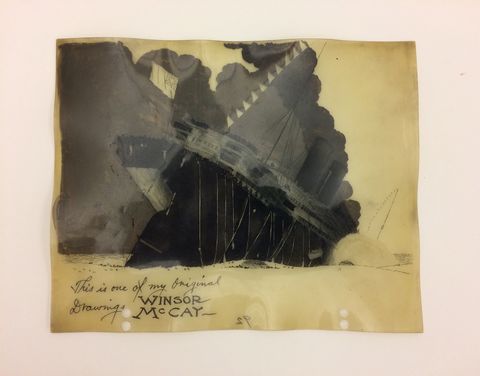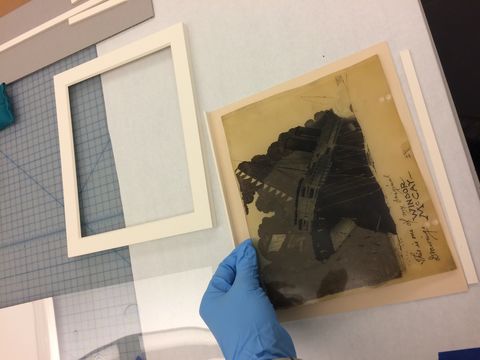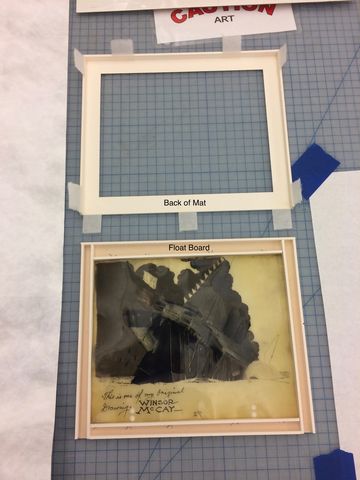At The Walt Disney Family Museum, we have a dedicated team of Preparators that utilize creative ways to display artwork in our galleries and special exhibitions. Preparator Ryan Mortensen works primarily with 2D objects, creating custom displays for the public to enjoy our collection of animation artwork.
We are lucky to have a large collection of animation cels at The Walt Disney Family Museum—some of the most sought-after objects amongst our guests. When these pieces of animation history are displayed in floor cases, they are typically presented in cel mat packages. These mounts can display just the cel, or layered cels, or cels on top of a background, otherwise known as a cel set-up. A mat that covers the margins of the object is vital, because safely mounting animation cels and backgrounds for exhibition typically requires additional mounting techniques.
In a museum exhibition, mat packages are typically displayed in either wall-mounted or floor-mounted display cases called “vitrines,” due to the clear acrylic enclosed display area. The term “mat package” refers to a mounting form for paper or other 2D objects that display artwork without the need of a frame or glazing.

Unlike mats that are placed in frames, the sides of mat packages are visible to the guest, so Preparators fabricate sides for the package from the same cotton rag matboard that mat windows are made of. Think of the packages as a mat with a built-in frame. In floor cases, mat packages are typically displayed on an angled mount called a “tilt.”
Like conventional mats, mat packages allow a portion of the object to be viewed by the guest through the “window”—what we call the square opening of the mat. The margins of the object that are obscured under the four “rails” of the mat are either unaesthetic, contain technical as opposed to aesthetic information, or are covered by pocket corners, polyethylene tape, or other mounting materials. The most common mounting technique for objects in mat packages in pendant hinging using washi paper—traditionally manufactured Japanese paper usually made from mulberry shrub bark—and wheat or rice starch paste.
Cels are made from paint applied to the back of a clear substrate. Early animation used cellulose nitrite, which was replaced by cellulose acetate, and then finally polyester after WWII. Cels cannot be hinged using paste and washi paper. If the object is presented as a cel set-up, then the background—typically ink and opaque watercolor—is mounted using pendant hinging, but the cels are mounted on top using one of the following: polyethylene pocket corners, polyethylene strips, polyester “fins,” entire sheets of polyester that span the entire mat window, or a combination of these techniques, particularly when the cels are as large or larger than the background and therefore able to have their bottom margin supported by a strip of 8-ply rag. The goal of this mounting technique is to allow the curator to display the cel set-up in a manner that approximates the view of the camera in the animation presentation. Sometimes the curator will choose to expand this view by expanding the mat window to make marginalia like registration holes and marks as well as artist or technician notes visible to the viewer.

On display in the museum’s first gallery is a cel from the earliest known animated documentary film in history, The Sinking of the Lusitania, created by Winsor McCay in 1918. The practice of serially photographing cels over static backgrounds, the use of registration pegs, and the monumental labor of producing a long-form animated film all presaged Walt Disney’s deployment of these same technologies, eventually resulting in the world’s first feature length animated film, Snow White and the Seven Dwarfs, which premiered in 1937. McCay used a thick celluloid as a substrate for his cels which has helped this object suffer less planar distortion and brittleness than other early cels, although it has yellowed significantly akin to other examples of the period.
Here you can see the Preparator testing the float board for the cel mat package; note that the hand is covered in a nitrile glove and that the cel is only being contacted in an area without applied media. The material used for the float board in this mount is not conventional cotton rag but micro chamber board; this substrate contains dispersed molecular traps for pollutants helping to preserve the case environment by trapping any acidic or corrosive outgassing that is common to early celluloid. Note the completed portion of the mount at the top of the image; the finished sides of mat were made from linear strips of cotton rag 8-ply and some extra pieces are visible in the top right portion of the photograph.

The image to the left is the mount just before the mat is attached over the artwork by folding the washi paper tabs and gluing them to the back of the float board. Note that there is no mechanical or chemical hinging—what Preparators call “attaching”—of the cel. It has simply been “boxed in” by linear strips of 8-ply cotton rag glued to the micro chamber float board. A moderate amount of polyvinyl acetate (PVA) glue is used to glue the top and bottom sides of this enclosure so that when the object is de-installed from the exhibition, the Preparator can easily remove them by pushing them down and away from the cel to break adhesion from the board before removing them. Then the Preparator uses a spatula and a gloved hand to safely remove the object.
–Ryan Mortensen
Preparator
The Walt Disney Family Museum
Image sources (in order of appearance):
-
McCay, Winsor; Cel from The Sinking of the Lusitania (1918); Collection of the Walt Disney Family Foundation
-
McCay, Winsor; Cel from The Sinking of the Lusitania (1918); Collection of the Walt Disney Family Foundation
-
McCay, Winsor; Cel from The Sinking of the Lusitania (1918); Collection of the Walt Disney Family Foundation
